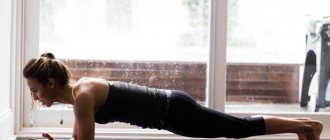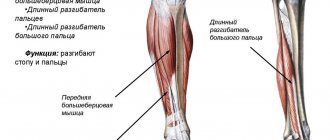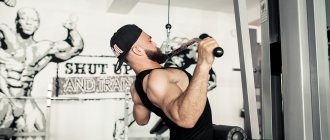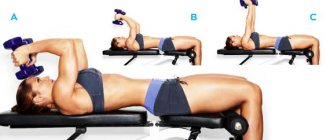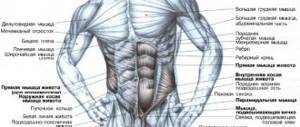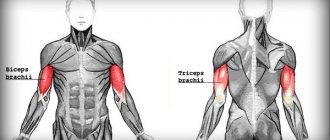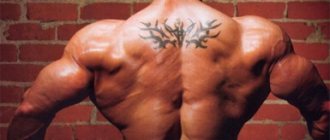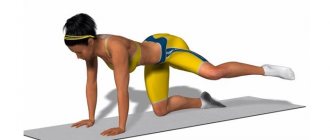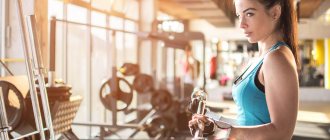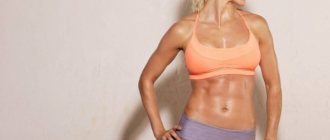Muscular man with ok sign
A beautiful and pumped up body always attracts the attention of the opposite sex. Many young boys and men are wondering how to pump up their torso? You may not have a triangular back and strong biceps, but a pumped up torso is the dream of any male. Next, let's look in detail at what will help make your dream come true.
Kicks with dumbbells
This is a good exercise to start your workout with as it is great for warming up, stretching your back, arms and shoulders.
- Take sports equipment (dumbbells) in each hand and raise them at chest level, imitating a boxing stance;
- Alternately, “throw” your arms forward in line with your shoulder, striking your intended opponent. Keep your hands at shoulder level, turning your palms as you strike;
- Continue the series of strokes for 1-2 minutes.
2
Read also[edit | edit code]
- Chest expansion
- Shoulders - exercises and training features
- How to make your shoulders wider
- Choosing exercises in bodybuilding
- The best training programs for mass
- How to create a training program
- Muscles of the shoulder girdle
- Exercises for the back and shoulders (for women)
- Training program for beginners
- Training program for professionals
- 4 rules for shoulder training
- How to pump up your shoulders (deltoids)
- Shoulder Exercises
Biceps exercise with dumbbells
This exercise targets the biceps, shoulders and upper back.
- Straighten your back with your feet shoulder-width apart;
- Tighten your core and squeeze your shoulder blades together;
- Take dumbbells, one in your hand, with your palms facing inward;
- At the same time, bring the dumbbells to your shoulders, bending your elbows, pausing for 1-2 seconds;
- Lower the dumbbells to your hips.
Important! Keep your elbows in the same position without changing it while lifting the dumbbells. You can also lift dumbbells by alternating arms instead of simultaneously.
Dumbbell press
This exercise will strengthen and enlarge the muscles of the entire torso, focusing on the chest, abs, shoulders and biceps.
- Sit on the edge of a flat bench press with your knees bent at right angles and your feet slightly wider than shoulder-width apart;
- Slowly sit back on the bench, holding dumbbells at chest level with your elbows bent at right angles;
- Extend your arms fully forward, keeping them above your body and keeping the dumbbells stable;
- Return your hands to the starting position.
Important! The weight of dumbbells should not exceed the permissible limits. You must keep them stable as you move up and down. Instead of a bench, you can do exercises on a fitball.
4
WHEN TO EXERCISE AND HOW MANY TIMES TO REPEAT?
When training with dumbbells, experts recommend focusing not on the intensity of the exercises, but on the total volume of the training load. All exercises must be performed correctly and efficiently. Performing a properly designed chest workout is enough just twice a week.
As for the required number of approaches, this value is very individual and it depends on the general fitness of the person and on the condition of his muscles. For one, the optimal training option would be 4-5 approaches to each exercise, and for another – 12-15. The whole question is that the load needs to be gradually and constantly increased, otherwise the muscles will stop growing and will simply be maintained in good shape.
To get into shape, experts recommend that beginner athletes begin their training with two approaches, gradually increasing them to 4-5 repetitions, and then to the optimal number of 10-12 approaches. In this case, dumbbells should be taken with the smallest possible weight, that is, 4 kg, and gradually increase this weight - adding “pancakes” to the dumbbells or changing the apparatus with a larger weight.
Lateral dumbbell raise in a bent position
Doing the exercise will help you strengthen the muscles of your upper back, arms, shoulders, and also improve your posture.
- Bend your knees, tilt your body slightly forward, and keep your back straight; Turn your palms towards each other, taking a weight in each. Keep your hands in front of you;
- Bend your arms very slightly at the elbow joints;
- Extend your arms to your sides, lifting them up and out. When lifting, keep your hands in line with your shoulders;
- Return to the starting position.
5
Standard push-ups
Regular push-ups are the easiest way to keep your pectoral muscles toned at home. Correct push-ups from the floor look like this: lying on straight arms, hands slightly wider than shoulders, head forms one line with the spine, abdominal muscles are in static tension. At the bottom point, you should pause for a moment, and then push yourself up with a powerful jerk, tensing your pectoral muscles at the top point. It is not necessary to straighten your elbows completely, and in some cases it is undesirable (stress on the joints).
Effect. Regular push-ups have a general beneficial effect on the upper part, but the main effect of the exercise technique is on the middle part of the chest muscles.
What guy doesn't want wide shoulders and a narrow waist? Pay attention to some nuances in your training to get that desired V-shaped athlete's torso and look more powerful even if genetically you do not have a wide shoulder girdle.
The look of massive shoulders tapering to a narrow waist makes bodybuilders stand out from the rest of the crowd. But that V-shaped torso is not the result of training just one muscle group.
To do this, you must train several muscle groups in the upper body and also work on the abdominal muscles. If you have a lot of fat around your waist, you may have to do cardio and a strict diet, or your "V" shape will resemble a "U" shape.
By tweaking your existing workouts, you can place more emphasis on those muscle groups that will make you stronger and wider from the waist to the shoulder girdle.
Make your shoulders wider.
Of the three deltoids - front, middle and back - the middle deltoids are the ones that give your shoulders the most width. By focusing on your middle deltoids, you can see faster results in your expansion.
Bench presses, overhead dumbbell presses, or vertical rows with a barbell and dumbbells to the chin, when the elbows go up and to the sides, work great for developing the entire shoulder girdle, but when you need to increase the volume of the middle deltoids, then not all “shoulder” presses work on them with the same share of the load.
Your task is to monitor how the shoulder muscles work. When you press dumbbells overhead, your elbows and forearms are spread out to the sides, and your arms go up in a “lateral” range. In this option, the middle beam gets a good reduction.
When you perform an Arnold press or a barbell press with the bar in front of you, your forearms are moved slightly forward rather than going straight through the “lateral” range. This small change in the movement vector removes some of the load from the middle beam, transferring it to the front.
The main thing here is not to make a mistake - an excellent exercise for developing the shoulders in general, but the dumbbell press has a “lateral” amplitude and is better aimed at the middle deltoids.
Likewise, any machine press in which your forearms and elbows are spread out to the sides will also do an effective job of hitting the middle deltoids.
What applies to presses also works for vertical rows. If you grab the barbell with a narrower grip, you will shift the load to the front deltoids; if you grip the barbell with a wider grip, the load will fall on the middle bunch.
What are the main functions of the shoulder - stabilizing the movements of the upper limbs while increasing the amplitude of their movements.
Simply put, the biomechanics of the shoulder joint allows you to move your arms in several projections at a wide angle and at the same time ensure strong attachment of a freely movable element (shoulder) to a conditionally movable element (scapula).
But quite simply, the shoulder rises and falls during multi-joint shoulder exercises. The same rule applies to isolated movements, such as dumbbell lateral raises, standing, sitting, so to effectively target the middle delts with isolated raises, watch the movement of your arms. They should only move in a “lateral” range of motion. Of course, you can move your arms out from behind your back or in front of you, but these are all nuances of working out from different angles, and this also takes place when you have already developed a decent mass of deltoids.
To focus the load more on the middle bands, add more than one isolated movement to your shoulder workout, such as dumbbell lateral raises, lat pulldowns, or lateral dumbbell raises while lying sideways on a positive incline bench.
You can also use training methods like forced reps or drop sets to generate a greater degree of muscle burn and increase mid-delt growth.
Pay attention to the development of the latissimus muscles.
Now we move from the middle deltoids to the well-developed latissimus muscles. They will also help you acquire a V-shaped body. Of course, back training includes several muscle groups (rhomboids, middle and lower back, trapezius and rear deltoids), but to create a V-shape, it is best to focus on developing the latissimus muscles.
In general, back training can be divided into two parts: movements such as pull-ups and rows, which are performed in a more or less vertical plane, and rowing movements, in which you pull almost perpendicular to your body.
Vertical movements help increase the width of the back, while perpendicular (horizontal) rows increase the thickness of the mid-back.
If you currently do pulldowns with a close-grip handle, try replacing the handle with a wide handle. And unlike the close-grip row, where you pull the cable towards your stomach, with the wide-handle row, perform the wide-grip row to put the load specifically on the lats.
Train your abdominal muscles and reduce your body fat percentage.
It may not be an easy task to achieve your goal because abdominal exercises alone are not enough to tighten your waist. It will take special effort to not only watch what and how much you eat, but also to stay in a calorie deficit every day.
Follow a smart fat-burning strategy, track your results, and do abdominal resistance training (crunch machines, cable crunch machines, standing, sitting, kneeling, exercise ball training with weights, hanging leg raises with weights) plus In addition to this, it’s cardio exercises to burn more calories. But at the same time, you should prioritize maintaining muscle while you lose fat.
This is how you should go about developing your abs by training your rectus abdominis. Start with sessions of 3-4 exercises every other day, starting with the most difficult movement and maintaining rest periods of no more than 30-45 seconds between sets, up to 2 minutes between exercises.
Developing a better V-taper for your body requires a two-pronged approach where you build muscle in your upper torso and remove fat from your belly. I didn’t make a reservation, we are not talking about local burning of fat in the abdominal area, no. We are talking about massive shoulders, powerful lats and a thin waist, which in turn distinguishes an athlete from an ordinary person.
The width of the torso is determined by the size of the lateral muscles of the back, crowned by the swinging deltoid muscles of the shoulders. Moreover, to achieve the desired result, it is necessary to concentrate specifically on increasing these muscles in width, and not in thickness. Also, don’t completely neglect performing basic exercises for the lower body. Without a comprehensive launch of the process of gaining muscle mass throughout the body, it is very difficult to selectively and noticeably increase it in some local area of the body. Therefore, the training program for broadening the shoulders and torso even includes barbell squats and deadlifts.
Monday
1) Deadlift - fix your back in a straight position with muscle effort even before you begin to lift the barbell from the floor.
Remove the barbell using your legs, not your back. Make sure that your legs do not straighten at the knees before your body finally reaches a vertical position. Otherwise, you will have to pull the weight with the force of your lower back - this is dangerous. 4 sets of 10-12 repetitions. 2) Bent-over barbell row - in order to concentrate on the latissimus muscles, grab the bar with a reverse grip slightly narrower than your shoulders. While performing the deadlift, your elbows should move straight back, being located as close to your body as possible. The tilt of the body relative to the floor should not exceed 45 degrees. 4 sets of 8-10 repetitions. Head pull-ups
3) Pull-ups by the head - grab the horizontal bar with a straight grip slightly wider than your shoulders, keeping your body as vertical as possible to the floor during pull-ups. Pull yourself up until the back of your head touches the bar and your shoulders form a line parallel to the floor. 4 sets of the maximum number of repetitions. 4) Lifting a dumbbell to the rear delta of the shoulder - lean on the bench as if you were going to perform dumbbell rows to your waist. Grab the dumbbell so that your forearms are facing backwards. Pull the dumbbell straight up until your shoulder is perpendicular to the body. 3 sets of 10-12 repetitions for each arm. 5) – sit on the training bench, holding the dumbbells in your hands. Bend your body forward, almost touching your chest to your knees. Using the force of the rear deltas alone, lift your arms, slightly bent at the elbows, up until they form a parallel with the floor and a perpendicular with the torso. 3 sets of 12-15 repetitions. 6) Lifting the barbell for biceps - perform the exercise very clearly, excluding swinging the body and lifting the elbows from the body . To maintain strict technique, you can press your back and elbows against the wall or use an arm blaster. 3 sets of 10-12 repetitions.
Wednesday
Dumbbell Bench Press
1) Dumbbell bench press - lower the dumbbells below chest level, maximally stretching the pectoral muscles and increasing the working amplitude. 4 sets of 8-10 repetitions. 2) - the angle of the bench should be within 35-45 degrees. The barbell is lowered onto the upper part of the pectoral muscles. 3 sets of 8-10 repetitions. 3) – keep your arms slightly bent at the elbow joints during the exercise, tilt your body slightly forward and bring your hands together at the waist. 3 sets of 15 repetitions. 4) – grab the bar wider than your shoulders, directing your effort to squeeze the barbell from your chest not only upward, but also to the sides, in order to engage both the front and side bundles of the deltoid muscles. 4 sets of 10-12 repetitions. 5) French press
– lower the barbell behind your head, at the top point of the amplitude, keep your arms not strictly perpendicular to the floor, but slightly tilted back. In this case, the load on the triceps muscles will be constant. 3 sets of 12 repetitions.
Friday
1) – hold the barbell on the upper part of the trapezius muscles, fixing your back with muscle force even before removing the barbell from the racks.
Lower yourself just below the parallel of your thighs with the floor, without lingering at the bottom of the squat. 4 sets of 8-10 repetitions. 2) – in the upper phase of the exercise, try not to place your chin over the bar, but touch it with the top of your chest. If the exercise is easy for you, then you can use weights or hold a dumbbell with your feet. 4 sets for the maximum number of repetitions. Vertical block row for the head
3) – do not tilt your head down to place the handle of the block behind your head. If the flexibility of your shoulder joints is not enough to place the handle behind your head without tilting your head, then simply turn your back to the machine. 3 sets of 15 repetitions. 4) - rest with one knee and hand on the bench, leaving the other leg to the side for stability. Pull the dumbbell with your free hand strictly towards your waist, stretching your back muscles to the limit at the lowest point. 3 sets of 10-12 repetitions for each arm. 5) – hanging leg raises and body raises on a bench. Both movements are performed extremely smoothly, without jerking or inertial force. 3 sets of the maximum number of repetitions in each exercise. The training program for expanding the shoulders and torso is designed for at least 6 weeks of use. But if during this time your body does not have time to adapt to it and continues to respond with growth, then its use can be extended.
Reverse kicks for triceps training
You probably already understood from the name that this exercise will pump up your triceps. Triceps are quite complex muscles that are practically not used in everyday activities. This means that if you don't work on them separately, you'll likely be on the path to flabby arms.
- Stand up straight and hold a dumbbell in each hand;
- Move your left leg forward, bending it at the knee;
- Tilt your body slightly forward;
- Press the elbow of your right hand to your body without releasing the dumbbell. Place your other hand with the dumbbells on your leg;
- Kick the right dumbbell back, straightening your elbow;
- Return to original stance;
- Repeat the approach with the other hand.
Important! During the “strikes”, do not move your shoulder; only your forearm should work.
6
How to get perfect abs and a great torso
First of all, I would like to weed out some WRONG advice...
No amount of training will give you those coveted abs.
No matter how simple or sophisticated these exercises are, they will not lead you to your desired goal.
Yes, ab exercises are necessary to develop a strong base (I'll have more to say about this below), but getting the look you want requires more than just ab workouts.
Just being thin is not enough.
In order for your six-pack to be fully visible, you need to have a fairly low body fat percentage, that's true. For guys, their abs start to show when their body fat is less than 10%; for girls, their abs are less than 20%.
But in fact, you can become very thin and still not have the defined abs you're aiming for.
How so?
The answer is simple: by default, no one’s torso is developed enough to reveal the deep relief and sculpted lines that make up a truly cool six-pack abs.
Take another look at the second example of poorly developed abs I showed earlier and my photos from two years ago.
Both he and I were about equally thin when they were done, but specific physique flaws would become much more apparent if we both lost 1-2% body fat.
A true six-pack requires a low body fat percentage and well-developed core muscles.
Deadlifts and squats alone, like cardio training, are also not enough.
I don't know how many times I've heard this: "I don't do abs, I just do squats and deadlifts." As a rule, these guys and girls have nothing to boast about in terms of their torso.
The reality is that these two exercises, even if you perform them with very heavy weights (80% 1RM), simply do not engage the muscles we want to target, i.e. the press itself, transverse and serrated, as people think.
Don't get me wrong, heavy squats and deadlifts are great for strengthening your core, but they're not the best way to build abs—they're not enough on their own.
What does it take to get great abs?
For a great abs and torso, you really only need two things:
- Reduce fat percentage.
For us men, the rectus abdominis does not begin to appear until we reach about 10%, the rest of the torso muscles are visible at 8% or less.
For girls, the tummy goes away and beauty begins already at 20%, and after 18% it’s already the dream abs.
Just be aware that no matter how well developed your core muscles are, you won't achieve the look you want if your body fat percentage is too high.
If you don't know how to lose weight, take a look at my series of articles on how to lose fat fast.
- Do proper abdominal and core workouts regularly.
How to pump up abs, what pumping exercises are the most correct? Let's find out...
Shoulder press
This exercise will help you tone your shoulder and upper back muscles.
- Straighten your arms, holding a dumbbell in each;
- Fix your palms at the top, then bend your elbows, imitating a right angle. Arms from shoulder to elbow should be parallel to the floor;
- Perform overhead lifts of weights;
- Return the hands with the dumbbells to their original position.
Important! In this exercise, the weight of the dumbbells is also important; it should not be too large, since when straightening the arms, they must be stable.
7
The best exercises for the abs and torso
To get great abs, we need to do both exercises that work the rectus abdominis muscles and those that target the other muscles in the core and complement the look we're aiming for when we bulk up.
How to pump up your abs to six-pack
The biggest mistake that most people make when doing what is called abs training is that they don't do weight training.
The result of this approach is the ability to do a million twists or leg lifts, even at home, and all this swinging - with a small and unexpressed press.
The abs are a muscle just like any other: to grow, they need progressive loads, and this can only be achieved by adding weights to the exercises.
You don't need to add weight to all the movements, but if you want to get a six-pack, some are worth adding.
My favorite abdominal exercises (including the lower ones) are the following:
- Cable crunches
- Captain's chair or horizontal bar leg raises (you can start with bent knees, but you should aim for straight leg raises)
- Hanging Leg Raise
- Bike
I didn't choose these exercises at random - research shows that they are an effective way to pump up the abs and are good for training the rectus and oblique abdominal muscles (unfortunately, the study has disappeared from the Internet, but it was conducted by Dr. Peter Francis in the Biomechanics Laboratory of San Francisco State University). Diego).
I have found that my abs respond best to a combination of weight-bearing and non-weight-bearing exercises. Here's how to make it beautiful:
- 1 set with a weight, such as cable crunches, captain's chair leg raises, or hanging leg raises, 10-12 reps (you can add weights for the last two by holding a dumbbell between your legs)
- Immediately after this, 1 set without weights to failure
- Rest 2-3 minutes
For example:
- 1 set of cable crunches, 10-12 reps
- Immediately after this, 1 set of leg raises in the captain's chair, to failure.
- Immediately after this, 1 set of bicycle, to failure.
- Rest 2-3 minutes
Do 6-9 of these circles 2-3 times a week and your abs and obliques will begin to develop. Now let's take a look at how we can train the rest of the core muscles.
How to develop the rest of your torso muscles
Heavy compound movements engage the core better than dedicated core exercises, especially when performed with submaximal weights (80%+ of your 1RM).
My three favorite core exercises are the deadlift, the squat, and the military press or overhead press.
If you do one of them every week, and with heavy weights, you won’t need any other core exercises.
Last but not least, I've mentioned the serratus muscles a few times, so let's talk about them.
How to develop serratus muscles
The serratus anterior are muscles attached to the ribs and similar in shape to fingers, they give the appearance of an athletic body.
Here is another recent photo of me, in which you can clearly see them (and also my wonderful son!)
While it is possible to work the serratus muscles with exercises like dumbbell pullovers, I don't think it's necessary. The exercises that really helped me develop my serratus muscles are…
- Deadlift
- Bent-over barbell row
- Dumbbell Bench Press
- Ab wheel exercises
Any good weight training program includes the first three points (heavy weights will work the serratus muscles better than light ones), and abdominal wheel exercises, which you can do at home, are one of the best for general core strengthening.
It is not news that a sculpted torso is an indicator of an individual’s excellent physical condition. Today, the most popular way to develop an athletic physique is visiting the gym + consulting a personal trainer. However, many people underestimate push-ups as an effective way to get beautiful chest relief. Let's look at the main types of push-ups, which, if performed regularly, will allow you to form a beautiful torso.
Vertical Dumbbell Raise
After completing this exercise, you will feel a pleasant pain in your shoulders, chest muscles and upper back, which will be the best proof of progress.
- Squat down slightly with your feet hip-width apart; Back straight, pelvis back.
- Take dumbbells, holding them in front of you with your palms facing your feet;
- Raise the dumbbells up to chest level, holding them in front of your body. The lift should be completed at the moment when the elbows are in line with the shoulders;
- Return your hands with dumbbells to their original position.
8
Plyometric push-ups
The technique for performing such push-ups on the floor is as follows. From the standard starting position, you need to jerk off the floor so that your hands are also in the air. When you land, drop slightly to the floor again and pull yourself up. “Level-up” for this type of push-ups: clap your palms and straighten your arms as an extension of the body at the top point.
Effect. Plyometric push-ups are an effective way to develop strength. This push-up technique allows you to increase the overall tone of the physiological system and involve a larger number of muscle fibers in the work.
Twisting (“Russian Twist”)
Performing this exercise comprehensively involves almost all muscle groups of the upper body.
- Bend your knees slightly, keeping your spine tight, then tilt your back slightly;
- Take a special fitness ball in your hands, holding it out in front of you at chest level;
- Turn to the left, pulling the ball with you in the same direction;
- Return to the starting position and do the same to the right.
If you don't have a ball, you can use a kettlebell, a dumbbell, or do curls without any weights at all. If you want to make it more challenging, elevate your legs and keep them off the floor while turning, which will increase the load on your abs and other muscles.
9
Basic mistakes
Having asked the question of how to pump up sculpted abs at home, we stock up on knowledge about what not to do:
1) borrow supposedly “professional diets” from the Internet or from friends - only a specialist can help you choose a balanced diet. What suits one person may harm another;
2) exhaust the body with excessive loads - the principle of an individual approach should remain the main one;
3) skip classes using original methods as an excuse;
4) increase the load unevenly - you can damage ligaments and muscles;
5) use the approaches of various sports doctrines. That is, if you are involved in fitness, you should not combine it with bodybuilding or gymnastics - it is impossible to achieve an ideal result with such a “mix”;
6) forget about other muscle groups, directing all the intensity only to this area - in combination with the flabbiness of the rest of the body, a pumped up stomach will look like a caricature;
7) ignore cardio stress (watch your heart and blood vessels, avoid their wear and tear)
Run on an empty stomach – increase the fats absorbed by the body after a run.
Push ups
Push-ups are a universal exercise that work different muscle groups, depending on the position of your hands. If your hands are shoulder-width apart, you will “pump up” your back and shoulders. By placing your hands closer together, you can target your triceps.
- Get into a high plank position;
- Bend your elbows and lower your chest down so that it does not touch the floor. Keep your body in one straight line;
- Straighten your elbows, returning to the starting position.
If you find it difficult to do push-ups while standing on your toes, try a kneeling position, gradually moving to a more difficult version. You can measure your own progress by the number of push-ups, doing them at the end of your workout or separately from your general workouts. But don’t be fooled by quantity and forget about quality!
We will provide you with a fitness level monitoring scale, but you can customize it based on your own abilities.
- Entry level - 1-5 push-ups;
- Average level - 6-10 push-ups;
- Advanced level - 11-20 push-ups;
- Expert - more than 20 push-ups.
The editor of most-beauty.ru tested the effectiveness of push-ups from his own experience. This is one of the few exercises where, at first, progress is quickly visible both in the number of maximum possible push-ups and in muscle growth.
10
WHERE SHOULD I START?
Anyone interested in how to pump up the pectoral muscles with dumbbells must first choose the right equipment, that is, a pair of dumbbells. In order for the training to really be useful, it must be quite heavy, but beginner athletes need to start with the weight that is most comfortable for them. Men's dumbbells, which can be purchased at sporting goods stores, are usually made for greater strength, so their weights start at 4 kg each. It is with such equipment that it is best for beginner men to practice.
According to experts, dumbbells of 4 kg each are just what you need to start with. As the muscles become stronger and more trained, the weight needs to be increased, but this must be done gradually. In order not to clutter your apartment with mountains, it is best to get dumbbells, the weight of which can be adjusted - add or remove “pancakes”, and exercise with benefit and pleasure.
In addition, it is important to choose and arrange the right place for training so that the training is comfortable and safe. Those who live on the ground floor are not so afraid of random shells falling on the floor, which cannot be said about residents of the upper floors, where the roar of a 4 kg shell falling on the floor will greatly frighten the neighbors below. Therefore, having chosen a place for training, you need to adapt it a little for training - for example, you need to put something soft on the floor, like a mat in a gym. The role of such a mat can be an old cotton blanket or feather bed folded in half or four.
